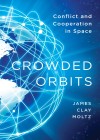Conflict and Cooperation in Space
Columbia University Press, New York, 2014, 193 pp
Hardcover ISBN: 9780231159128
Author: James Clay Moltz
Reviewed By: Steven Henry
James Clay Moltz’s Crowded Orbits: Conflict and Cooperation in Space is an insightful examination of the challenges and opportunities in the space domain, making it essential reading for Defence space professionals, and those seeking to understand this critical domain better. The book leverages the ‘congested, contested and competitive’ description of space coined in 2011 United States National Security Space Strategy, which is increasingly relevant today.[1]
Crowded Orbits ‘assumes no particular background in space science, history, or politics, but provides a foundation in each of these areas so the reader can approach complex subjects regarding the future in space with new knowledge and understanding.’ [2]
Published in 2014, the book predates some recent developments including the establishment of Australia’s Space Command in 2022, China’s rise as a space power, and an intensified military focus by many nations. Nevertheless, Crowded Orbits remains a foundational text. Moltz’s ability to dissect complex geopolitical and strategic issues makes it essential reading for those seeking to grasp the long-term implications of space for national security.
One of the book’s most valuable contributions is its exploration of the shift from a Cold War-dominated space race to the current environment. Moltz discusses how, during the Cold War, space was primarily an arena of competition between the United States and the Soviet Union. This period was characterised by military uses of space, as well as significant cooperative achievements like the Apollo-Soyuz Test Project.
Moltz then charts the rise of new spacefaring nations and commercial entities, showing how space has become more crowded. He highlights China’s growing capabilities but arguably underestimates the growth we have seen since publication. He also discusses Russian activities, and the increasing involvement of commercial actors such as SpaceX. The strategic implications of these developments, such as the weaponisation of space, the proliferation of satellites, and the increasing risk of space debris, are discussed in detail, offering valuable insights for space professionals tasked with managing space-related capabilities and risks in a more congested and contested environment.
Moltz’s discussion on the military use of space is especially pertinent. He highlights how space has become a critical domain for military operations, providing capabilities such as positioning, navigation and timing (through systems like the US Global Positioning System) and what is now near-persistent global intelligence, surveillance and reconnaissance. Adding essential satellite communications and environmental monitoring (including weather) capabilities to this list makes it clear why land domain professionals are well advised to seek to improve their understanding of the space domain. Moltz’s analysis of anti-satellite (ASAT) weapons and the threats posed by space debris is a critical part of any effort to understand the risks Australia and its allies face in assuring their space capabilities are available to enable the integrated force.
Moltz also emphasises the dual-use nature of many space technologies. Satellites designed for commercial purposes, such as communications and environmental monitoring, can also serve military functions. This dual-use aspect is important as Defence looks to enhance its space capabilities, while remaining a responsible actor in space, and leveraging capabilities across the gamut of national security purposes, including humanitarian aid and disaster relief.
The book’s emphasis on space situational awareness (SSA) is useful, as it underscores the need for Australia to continue develop capabilities to monitor space activity, track objects, and protect its assets from interference. This resonates with Defence’s recent efforts to develop stronger space domain awareness (SDA) capabilities in collaboration with allies and commercial and civil partners, exemplified by the Commercial Data Mission Centre[3] in Adelaide. Moltz’s work serves as a critical reminder that SSA is not just about technology but also about international cooperation and coordination—two areas where Australia must continue to play a role.
Despite the increasing risks and congestion in space, Crowded Orbits offers a balanced view, advocating for cooperation over conflict. Moltz argues that, while space has become more militarised, it remains a domain ripe for international collaboration, especially in managing global challenges like space debris, environmental monitoring, and disaster response. His focus on the need for new norms, rules, and cooperative agreements is something space professionals should carefully consider as Australia expands its role in space.
Moltz’s detailed suggestions for governance reforms, which emphasise peaceful cooperation and the importance of the international rule of law, would benefit Australian civilian and military space policy developers. Moltz advocates for strengthening international agreements such as the Outer Space Treaty and developing new frameworks to address modern challenges, such as space traffic management and debris mitigation. These are key areas where Australia can demonstrate its commitment to remaining a responsible space actor and supporting the rules-based global order.
For Australian military professionals with an eye on space, Crowded Orbits is not just historical context, it provides enduring lessons about the nature of the space domain that remain applicable today. One of the book’s great strengths is its clear and detailed discussion of the intersections of space policy, military strategy, and international relations. As Australia seeks to build its own space capabilities, learning from the successes and failures of other nations is critical. Moltz’s discussion of the challenges faced by the United States and other space powers offers valuable insights for avoiding similar pitfalls. Moreover, Moltz’s call for cooperation in space, particularly among allied nations, aligns well with Australia’s own strategic interests. Australia’s Defence Strategic Review has emphasised the importance of working with international partners to ensure access to space capabilities. Moltz’s analysis serves as a reminder that Australia must not only develop sovereign capabilities but also foster cooperation with international partners, continuing work within frameworks like the Combined Space Operations initiative and Operation Olympic Defender, to navigate the challenges of the increasing congested, contested and competitive space domain.
Crowded Orbits is a must-read for aspiring space professionals within Defence. While it predates some of the most recent developments in space, its analysis of the geopolitical and military dynamics of space remains highly relevant. Moltz offers a thorough understanding of space’s challenges and opportunities, providing a foundation for comprehending the future developments in space power. As Australia strengthens its commitment to space as a critical domain for national security, Moltz’s insights into the congested, contested, and cooperative nature of space will remain a guiding resource for military professionals looking to navigate this complex landscape.
Second Edition:
Hardcover ISBN: 9780231207065
Paperback ISBN: 9780231207072
eBook ISBN: 9780231556798
Endnotes
[1] U.S. Department of Defense & Office of the Director of National Intelligence National Security Space Strategy: Unclassified summary. (U.S. Government Printing Office, 2011)
[2] James Clay Moltz, Crowded Orbits: Conflict and Cooperation in Space (New York: Columbia University Press, 2014), p. 5.
[3] It’s all systems go for Space Command at Lot Fourteen – SASIC



